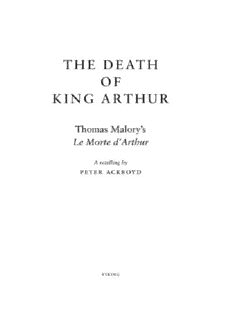
The Death of King Arthur PDF
Preview The Death of King Arthur
Table of Contents Title Page Copyright Page Introduction THE TALE OF KING ARTHUR Merlin The Knight with the Two Swords Arthur and Guinevere The Wickedness of Morgan le Fay THE ADVENTURES OF SIR LANCELOT DU LAKE TRISTRAM AND ISOLDE Isolde the Fair Tristram’s Madness and Exile Tristram and the Round Table The Reunion of Tristram and Isolde THE ADVENTURE OF THE HOLY GRAIL The Miracle of the Holy Grail The Quest Begins The Quest Goes On Lancelot and Galahad The Miracle of Galahad LANCELOT AND GUINEVERE The Poisoned Apple The Fair Maid of Astolat The Knight of the Cart THE DEATH OF ARTHUR The Strife Begins The Vengeance of Gawain Lancelot and Gawain The Day of Destiny The Dolorous Death and Departing out of This World of Sir Lancelot and Queen Guinevere VIKING Published by the Penguin Group Penguin Group (USA) Inc., 375 Hudson Street, New York, New York 10014, U.S.A. Penguin Group (Canada), 90 Eglinton Avenue East, Suite 700, Toronto, Ontario, Canada M4P 2Y3 (a division of Pearson Penguin Canada Inc.) Penguin Books Ltd, 80 Strand, London WC2R oRL, England Penguin Ireland, 25 St. Stephen’s Green, Dublin 2, Ireland (a division of Penguin Books Ltd) Penguin Books Australia Ltd, 250 Camberwell Road, Camberwell, Victoria 3124, Australia (a division of Pearson Australia Group Pty Ltd) Penguin Books India Pvt Ltd, 11 Community Centre, Panchsheel Park, New Delhi – 110 017, India Penguin Group (NZ), 67 Apollo Drive, Rosedale, Auckland 0632, New Zealand (a division of Pearson New Zealand Ltd) Penguin Books (South Africa) (Pty) Ltd, 24 Sturdee Avenue, Rosebank, Johannesburg 2196, South Africa Penguin Books Ltd, Registered Offices: 80 Strand, London WC2R oRL, England Translation, retelling and introduction copyright © Peter Ackroyd, 2010. All rights reserved. ISBN : 978-1-10154590-4 Without limiting the rights under copyright reserved above, no part of this publication may be reproduced, stored in or introduced into a retrieval system, or transmitted, in any form or by any means (electronic, mechanical, photocopying, recording or otherwise), without the prior written permission of both the copyright owner and the above publisher of this book. The scanning, uploading, and distribution of this book via the Internet or via any other means without the permission of the publisher is illegal and punishable by law. Please purchase only authorized electronic editions and do not participate in or encourage electronic piracy of copyrightable materials. Your support of the author’s rights is appreciated. http://us.penguingroup.com Introduction Sir Thomas Malory came from a family steeped in the values and traditions of the chivalric code. His ancestors were ‘gentlemen that bear old arms’, and their blood relationship with both the Normans and the Vikings suggests that they were sufficiently robust to do so. They had settled at Newbold Revell, in Warwickshire, and had managed to acquire vast estates throughout that county. As the inheritor of a name and domain, Malory himself was ineluctably drawn into the contests of the wider world. He was born, in the first decade of the fifteenth century, at a time of great violence and uncertainty. Richard II had been deposed and murdered in 1400; his successor, Henry IV, was continually beset by all the confusion that surrounds any successful rebel. So the realm was disordered. This context of suspicion and almost continual violence can be glimpsed in the pages of Le Morte d’Arthur, most particularly in the conflict between Arthur and Mordred. In this period of battles, and rumours of battles, there can be little doubt that Malory would have been acquainted with the great chivalric tales of the age. They were part of any gentleman’s education. He would have heard readings of Brut and the alliterative Morte Arthur, those great clarion calls to the knightly spirit. He would also have attended jousts and tournaments, where the words of the ballads and epics took on a formidable and glamorous life. We may apply to the young Malory his own words, ‘This child will always be shooting or casting darts, and is glad to see battles and prancing knights.’ He was also trained in all the feudal arts of chivalry – arts that included hunting, riding, hawking and archery. His earliest biographer, writing in the sixteenth century, described him as ‘outstanding from youth for his heroic spirit and for many remarkable gifts’. At the age of fourteen, in fact, he went to war against France in the retinue of the Earl of Warwick. He served as a ‘lance’ at Calais and four years later he was mentioned at a muster roll in Normandy. In that capacity he may have participated in the siege of Rouen, and was part of the army under the command of Henry V. It is perhaps not coincidental that Henry V was often compared to the legendary Arthur. In 1433 or 1434, while he was in his early twenties, Malory inherited the familial estate; eight years later he became a knight, the goal of all chivalric ambition. He also became Justice of the Peace, Member of Parliament, and Sheriff of Warwickshire. These were all highly significant positions,
